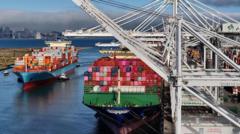US President Donald Trump has enacted comprehensive tariffs on more than 90 nations globally, challenging existing trade relationships and altering the dynamics of international commerce. Just before his deadline for negotiations expired, Trump took to Truth Social to announce that these import taxes are channeling billions into the US economy.
These tariffs form part of Trump's strategy to resurrect jobs and manufacturing in America while addressing what he perceives as imbalances in the global trade framework. The President specifically targeted India, threatening to elevate import duties from 27% to a staggering 50% if the country continues purchasing oil from Russia. In response, India criticized the measure as "unfair and unreasonable," pledging to secure its economic interests amidst global pressures.
Trump’s tariffs represent an elevated average on imported goods not seen for nearly a century and reflect a layered effort to reformulate the US's position in the world economy. Importers of goods now face additional costs, which may ripple through to consumers, affecting prices across various sectors. Trump's focus appears to be on those countries with substantial trade links to China, reflecting his ongoing conflict with Beijing.
Notably, the tariffs impose significant hardships on export-driven economies in Southeast Asia, with countries like Laos and Myanmar facing rates as high as 40%. Surprisingly, markets in Asia remained stable following the tariff announcements, with key stock indexes in places like Japan and China showing slight gains.
Meanwhile, agreements have been reached with major economies, including the UK and EU, ensuring reduced tariff rates for their exports to the US, although Switzerland faces a significant blow with a 39% tariff. Taiwan is also embroiled in this trade conflict, grappling with a current 20% rate while attempting to negotiate a resolution.
The latest round of tariffs also ties into broader geopolitical concerns, linking economic policies with efforts to influence Russia's actions in Ukraine. Trump's tendency to threaten secondary tariffs against Russia's trading partners introduces an unpredictable element to international relations, potentially discouraging cooperation among nations still doing business with Moscow.
In the tech sector, the potential imposition of a 100% tariff on foreign semiconductors elicited a swift response from Apple, which announced a significant $100 billion investment in the US aimed at alleviating governmental pressure for domestic production.
As this economic landscape evolves, experts warn that while Trump celebrates his tariff victories, they could provoke deeper economic conflicts and lead to higher costs for American consumers, ultimately revealing the complexities of a renegotiated global trade system.




















